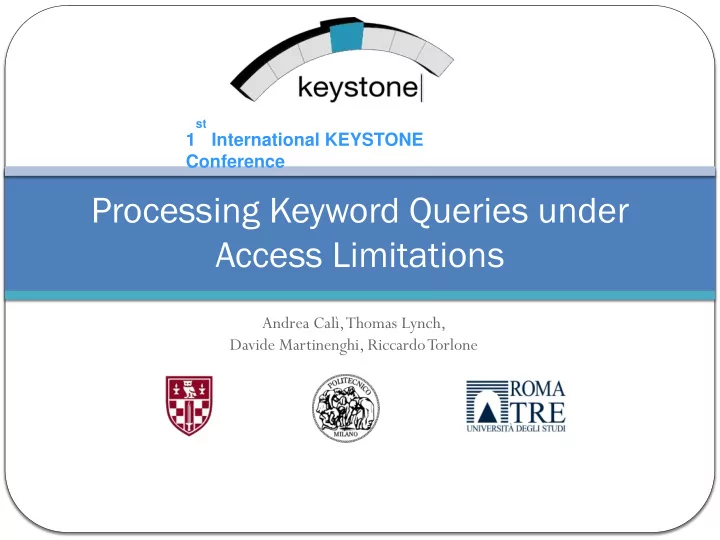

st 1 International KEYSTONE Conference Processing Keyword Queries under Access Limitations Andrea Calì, Thomas Lynch, Davide Martinenghi, Riccardo Torlone
What is the Deep Web? Web pages (HTML mostly) have been indexed and searched for many years Such pages constitute the so-called Surface Web huge, valuable amount of information The web has also continuously “deepened” searchable databases, accessible usually through forms The Deep Web (aka Hidden Web or Invisible Web) is not effectively crawlable nor indexeable it is largely unexplored, apart from manual queries issued by users
Conceptual view of the Deep Web [He et al. 2007]
Modeling the deep Web Each source is modeled as a relational table with access limitations Access limitations: input vs output attributes We can only access a table if we can provide a value for every input attribute Access pattern: maps attributes into an access mode: input (i) or output. People(FirstName,LastName i ,State)
Keyword Search in the Deep Web Accessing the deep Web: Traditionally, conjunctive queries over data sources with access limitations Goal: Provide an high-level access to Deep Web Free the user from the knowledge of: Query languages Structure of data sources Approach: Keyword-based queries
Join graph
Answers to keyword queries A keyword query is a set of constants called keywords An answer to a keyword query q against a database instance r over a schema R with access limitations is a set of tuples A in the reachable instance such that: 1.Each keyword in q occurs in at least one tuple t in A; 2.the join graph of A is connected; 3. for every subset A’ of A such that A’ enjoys Condition 1, the join graph of A’ is not connected. An answer is optimal if it has minimum size.
Computing an optimal answer t 31 t 21 t 11 t 21 t 31 t 12 t 11 t 11 t 23 t 33 t 23 t 33
A method for computing an answer A brute-force approach: 1.Extract the reachable portion 2.Find an optimal (or at least minimal) answer in the reachable instance
Data complexity 1. Extraction of the reachable instance It can be implemented by a Datalog program P over the input database d, P can be evaluated in polynomial time in the size of d [Vardi 82]. 2. Determining an optimal answer from the reachable instance It corresponds to finding a Steiner Tree (ST) of its join graph, i.e., a minimal-weight subtree of this graph involving a subset of its nodes. STs can be enumerated in ranked-order with polynomial delay, i.e., the time for printing the next optimal answer is polynomial in the size of d [Kimelfeld and Sagiv 2006]. An optimal answer to a keyword query against a database instance with access limitations can be efficiently computed under data complexity
Conclusions Formalization of keyword-based query answering in the Deep Web Preliminary insights on possible methods for computing optimal answers It turns out that: The problem it is not easy to solve even over a few data sources Traditional techniques for query answering in the Deep Web need to be revised Even in the worst case the problem remains tractable
Current and Future work Optimization strategies for query answering conditions under which an optimal answer can be derived without extracting the whole reachable instance; Implementatio n based on the Dataplex framework Adoption of schema-based techniques e.g, when the domains of the keywords are known in advance Take into account source availability and proximity they can be modeled as weights on nodes and arcs, respectively
Recommend
More recommend